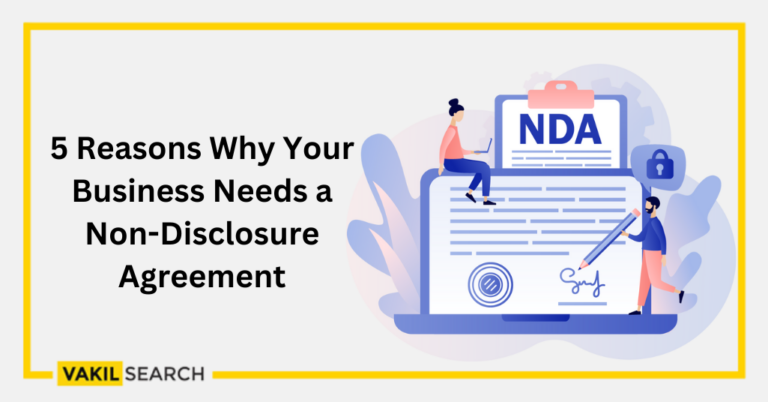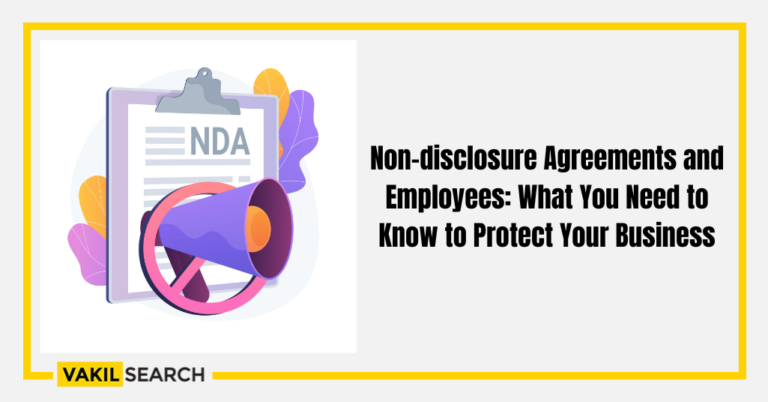You can decide to terminate an NDA in situations which call for it. There are the 6 clauses to consider while terminating a non-disclosure agreement. Know how to terminate a non-disclosure agreement.
Introduction
You can decide to terminate an NDA in situations that call for it. There are 6 clauses to consider while terminating a non-disclosure agreement. Learn about all the Ways To Terminate A Non-Disclosure Agreement (NDA).
A non-disclosure agreement (NDA) is a contract in which one or both parties agree to keep specified information from the other party confidential. This includes not releasing the information to unauthorised third parties and pledging not to use it without the consent of the disclosing party. You need to be aware of NDA Termination Clause in such cases.
Why Is an NDA Drafted?
Typically, an NDA is drafted for the advantage of the party making the private disclosures (‘Disclosing Party’). The party receiving the confidential information (‘Receiving Party’) agrees to be constrained and bound by confidentiality obligations in exchange for any potential advantage received from the Disclosing Party. This could be a lucrative licensing deal, a job offer, or the prospective purchase of the Disclosing Party’s firm.
NDAs are frequently seen in employer-employee employment agreements, joint venture partnerships between two Organisations, license agreements, and independent contractor hiring agreements.
2 Types of NDA Agreement
In this section, we will discuss the types of NDA agreements.
1. One-way or Unilateral NDA
One-way agreements simply seek to guarantee the confidentiality of one party’s information and are typically used when only one party plans to disclose information
2. Mutual Non-Disclosure Agreement
Mutual agreements are typically written to protect both parties’ information equally, and both parties must maintain confidentiality. These cooperative agreements are typically more balanced because both parties have equal bargaining power.
The Key Terms of Non-Disclosure Agreements
Non-Disclosure Agreements do not have to be lengthy and complex. The best ones are usually only a few pages long.
The following are the essential components of Non-Disclosure Agreements;
- Identification of the parties
- Definition of what is considered secret
- The scope of the receiving party’s confidentiality duty
- Exclusions from confidential treatment
- The period of the agreement.
We can get the number of Services if we have the correct NDA Information on all the Aspects.
How to Terminate an NDA?
In this section, we will cover how to terminate an NDA.
1. Go Over the ‘Duration’ Clauses
A good NDA will have two separate duration terms. To begin, there is a term for the NDA itself, which is the effective period for the agreement during which both parties will be in a commercial connection. For example, the parties may decide to enter into negotiations for a license relationship for a year.
A suitable agreement will also include a second term that specifies how long confidentiality obligations are expected to last. Because confidentiality duties usually remain after the NDA has expired or been cancelled, this is usually a separate term from the NDA itself.
In other words, when the agreement expires, the confidentiality obligations do not automatically end.
2. Go Over the Termination Clause
Business partnerships, like any other type of connection, can terminate abruptly. Similarly, a party that has signed an NDA agreement may decide that she or he wants to cancel the agreement before the agreed-upon termination date.
This could happen for a variety of reasons, including;
- It might be that the terminating party learned that the parties are not a good fit for each other after all, or that the other party did not have as much to offer to the agreement as planned
- It could also be that the terminating party simply changed their thoughts, and so on.
The termination clause should additionally include the following information;
- How the intention to terminate should be communicated to the other party (for example, in writing)
- And whether any notice period is required before termination takes effect
- If the NDA is a one-way or unilateral agreement and the terminating party is the party that made the disclosures, then terminating the NDA is generally not a big deal because the contract was made for that party’s benefit anyway.
- You Can Read more About the Financial Agreements in Business Online.
However, it is crucial to note that the Receiving Party is still likely to be bound by any secrecy requirement for material that has already been received, depending on the confidentiality period mentioned in the NDA.
Similarly, if the party wishing to terminate is the party who got private information in a unilateral agreement, the Receiving Party will still be bound by the requirement of confidentiality for the duration provided in the NDA if properly structured.
3. Examine the ‘Return of Information’ Provision
Another crucial clause to consider requires the return of secret information upon expiration of the NDA agreement. This section specifies whether one party is required to return or delete private information once an NDA ends and when such action must be taken.
This provision can require the other party to return all information, destroy all copies of the material, and provide proof that they have done so. The clause can also include a promise not to create any additional copies of the material.
You can state in this paragraph that the other party must restore all information to you, destroy any copies of material in their possession, show you confirmation that they have done so, and possibly agree not to make any more copies from then on.
4. Indemnity Clause
An indemnity clause is frequently a stumbling block in NDA talks. An indemnification clause stipulates that if the confidentiality agreement is breached, one party (the ‘indemnifier’) undertakes to pay the other party (the ‘indemnified’) an agreed amount.
Before agreeing to an indemnification clause, make sure your contractual obligations are confined to your own malfeasance or errors. If you have any further questions about indemnity clauses or other parts of NDAs, you should consult with your lawyer.
5. Survival Clause
A survival provision prevents the agreement from being terminated. This provision says that the restrictions imposed by the NDA will remain in effect after the agreement expires. The agreement does not imply that confidentiality will be maintained continuously. A confidentiality clause normally lasts for two to four years after the agreement is terminated.
6. Clause of Non-Solicitation
A non-solicitation clause prevents the person receiving the NDA from recruiting staff for your company. If you share useful information with a possible partner or investor, the individual may wish to hire employees from your workforce since they have similar expertise that could make them especially valuable. A non-solicitation agreement will help shield your employees from future competitors.
How to Get Out of a Non-Disclosure Agreement
One option to get out of an NDA is when the contract’s term expires. Another possibility is that the contract is terminated by its termination clause.
However, in some situations, your legal duties to maintain confidentiality can last for many years. As a result, before signing an NDA, you must read and comprehend its conditions.
Conclusion
Ultimately, after the contract term expires, the NDA is terminated. Another option to get out of an NDA agreement is to follow the termination clause’s requirements. However, before signing your contract, you must read the fine print. In some circumstances, this confidential agreement may last long after the contract has expired in some circumstances.
Frequently Asked Questions
When can an NDA be void?
An NDA may become void if a party breaches confidentiality, the disclosed information becomes public, or the purpose of the agreement is fulfilled.
What is the termination language for an NDA?
Termination language in NDAs typically outlines conditions like mutual consent, completion of the purpose, or a specified period, ensuring a clear end to the confidentiality obligations.
How strict are NDAs?
NDAs vary in strictness based on factors like industry norms and the sensitivity of the information. Some may have stringent clauses, while others are more lenient, depending on negotiation and the parties involved.
Do NDAs require two signatures?
Yes, most NDAs require signatures from both parties for legal validity, ensuring mutual commitment to confidentiality.










